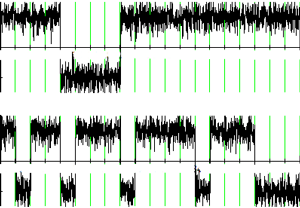Multiplicative complementary binary signal-code constructions
DOI:
https://doi.org/10.3103/S0735272718100011Keywords:
complementary sequences, peak sidelobe level, sidelobe suppression, correlation properties, signal detection, signal processingAbstract
There are proposed signal-code constructions consisting of two or more components shaped on a basis of binary sequences with a property of multiplicative complementariness of their matched filtering results. There are considered systematically the rules of synthesis of such binary sequences containing signal-code constructions; there are described analytically their correlation properties, their processing specificities and the structure of obtained resulting signal. On a basis of statistical model of correlated signal components and their clusterization there is shown theoretical continuity of proposed signal-code constructions and Barker’s binary sequences. There are represented the examples of shaping, processing and parameters of researched signal-code constructions. It is carried out comparative analysis of structural specificities and noise immunity of multiplicative complementary signal-code constructions with complementary sequences (Golay’s codes), i.e. signal-code constructions with property of additive complementariness, there are exposed their advantages and drawbacks regarding spectral characteristics and signal detection characteristics (errors of the first and second genus).References
- BOUHEDJEUR, H.; TOURCHE, K.; ABBADI, A.; BENCHEIKH, M.L.; MAGAZ, B. “Investigation of a joint I/Q demodulation/pulse compression scheme for radar applications,” Proc. of Seminar on Detection Systems Architectures and Technologies, 20-22 Feb. 2017, Algiers, Algeria. IEEE, 2017, p.1-5. DOI: https://doi.org/10.1109/DAT.2017.7889150.
- GANTMAKHER, V.E.; BYSTROV, N.E.; CHEBOTARIOV, D.V. Noiselike Signals. Analysis, Synthesis, Processing [in Russian]. St. Petersburg: Nauka i Tekhnika, 2005.
- STÄRKE, P.; FRITSCHE, D.; CARTA, C.; ELLINGER, F. “A passive tunable matching filter for multiband RF applications demonstrated at 7 to 14 GHz,” IEEE Microwave Wireless Components Lett., v.27, n.8, p.703-705, 2017. DOI: https://doi.org/10.1109/LMWC.2017.2724006.
- NUNN, C.J.; COXSON, G.E. “Best-known autocorrelation peak sidelobe levels for binary codes of length 71 to 105,” IEEE Trans. Aerospace Electronic Syst., v.44, n.1, p.392-395, 2008. DOI: https://doi.org/10.1109/TAES.2008.4517015.
- SCHMIDT, Kai-Uwe. “Binary sequences with small peak sidelobe level,” IEEE Trans. Inf. Theory, v.58, n.4, p.2512-2515, 2012. DOI: https://doi.org/10.1109/TIT.2011.2178391.
- XU, Lei; LIANG, Qilian; JIANG, Ting. “A ternary pulse compression code: Design and application to radar system,” Proc. of IEEE Int. Conf. on Acoustics, Speech and Signal Processing, 14-19 Mar. 2010, Dallas, TX, USA. IEEE, 2010, p.4050-4053. DOI: https://doi.org/10.1109/ICASSP.2010.5495762.
- FRIESE, M. “Polyphase Barker sequences up to length 36,” IEEE Trans. Inf. Theory, v.42, n.4, p.1248-1250, 1996. DOI: https://doi.org/10.1109/18.508850.
- MURALIDHARA, N.; RAJESH, B.; BIRADAR, Rajashekhar C.; JAYARAMAIAH, G.V. “Designing polyphase code for digital pulse compression for surveillance radar,” Proc. of 2nd Int. Conf. on Computing and Communications Technologies, 23-24 Feb. 2017, Chennai, India. IEEE, 2017, p.1-5. DOI: https://doi.org/10.1109/ICCCT2.2017.7972239.
- JEDWAB, Jonathan; PARKER, Matthew G. “A construction of binary Golay sequence pairs from odd-length Barker sequences,” J. Combinatorial Designs, v.17, n.6, p.478-491, 2009. DOI: https://doi.org/10.1002/jcd.20222.
- BYCHKOV, V.E.; MRACHKOVSKY, O.D.; PRAVDA, V.I. “Golay’s codes application features in radiolocation,” Radioelectron. Commun. Syst., v.51, n.4, p.210-214, 2008. DOI: https://doi.org/10.3103/S0735272708040055.
- HOLUBNYCHYI, A.H. “Generation of generalized binary Barker sequences and their structure,” Problems of Informatization and Management, v.4, n.44, p.20-26, 2013. URI: http://jrnl.nau.edu.ua/index.php/PIU/article/view/6359.
- CHEN, Bin; WU, Yaqiong; TAO, Bo; ZHENG, Ying. “Entropy-clustering and K-means based kernel partial least squares soft-sensing method,” Proc. of 36th Chinese Control Conf., 26-28 July 2017, Dalian, China. IEEE, 2017, p.2139-2143. DOI: https://doi.org/10.23919/ChiCC.2017.8027672.

Downloads
Published
2018-10-30
Issue
Section
Research Articles

